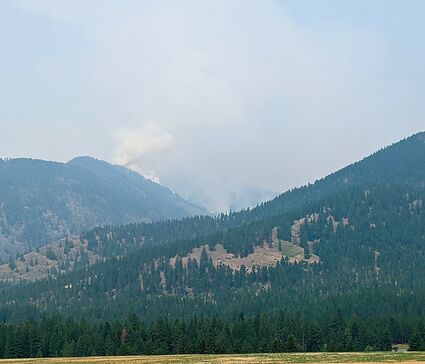Hot, dry weather fuels wildfires, Stage 2 remains
July 22, 2021
Too hot, too dry, too soon.
The 2021 wildland fire season could very well turn into one of the longest campaigns in modern firefighting history if this area does not receive a break from the seemingly unending heat wave residents have been suffering through for several weeks now.
As a result of the situation, Sanders County remains under Stage 2 fire restrictions and the current fire danger is rated at Extreme in all parts of the county.
The organization in charge of more than 10 lightning-caused wildland fires on the Plains/Thompson Falls and Superior ranger districts for the last 10 days, the West Lolo Complex IMT (Incident Management Team) has whittled that list of fires down by systematically putting them out to only two by early this week, but those two are big ones – the 365-acre Deep Lookout Mountain Fire 12 miles southeast of Superior and the 2,043-acre Thorne Creek fire approximately seven air miles north of Thompson Falls.
The West Lolo Complex team has contained and returned several fires they were originally tasked with to the host units. This means that, on the Plains/Thompson Falls RD, the 20-acre Siegel fire, the 8-acre Quinn's fire and the 3-acre Sheep fire (all burning in the cutoff area southeast of Paradise) have all been contained and turned back to the district, as well as a few smaller fires burning in the Graves Creek area.
A similar process of returned fires has occurred on the Superior RD.
The incident commander for the Type 1 West Lolo Complex team, which is expected to transition out later this week when the Thorne Creek fire is given back to the Plains/Thompson Falls RD and a smaller Type 3 organization, Mike Goicoechea warned that the fire season is far from over.
"I would like to highlight the fact that we remain at Preparedness Level 5, the highest level of fire preparedness, and that there are a total of 12 IMT teams working on incidents in this geographical area," Goicoechea said at a stakeholders' meeting in Thompson Falls Tuesday. "The competition for firefighting resources, including personnel and aircraft, is intense. There is not enough to go around for all the fires."
With possible thunderstorms moving into the area earlier this week, Goicoechea says his team remains on high alert. "There is a potential for some more lightning-caused fires," he said, "and we are poised and ready for any new starts."
The Thorne Creek fire is proving to be the most challenging for firefighters to get a handle on, mainly due to its location.
Posing extreme risk to firefighters due to steep, rugged, rocky terrain and due to the fact that there is no road access to the fire area, the Thorne fire (which merged with the smaller Winniemuck fire earlier this week) is being managed as a full suppression fire utilizing indirect line opportunities.
Still edging its way down the Thorne and Winniemuck drainages, the fire is being closely monitored as managers seek opportunities to bring the blaze into control without endangering ground crews unnecessarily. Although the fire has reached the high country, the team operations chief indicated that the fire has largely stopped spreading in the alpine terrain to the east.
Being proactive at points where it is felt that the fire could eventually move closer to the Clark Fork River valley bottom, the team has enlisted personnel and heavy equipment to construct indirect control lines along the base of Silcox Mountain from Weber Gulch trailhead to the Thompson River road. Prep work is also ongoing with residents along the Thompson River road.
The team said they have had success working with the public in getting this work done, noting the close coordination with private landowners and cooperators for line construction placement that they enjoyed.
One thing Thompson Falls has going for it is that the townsfolk are accustomed to dealing with large wildfire events, after having lived through 2016 (when Copper King burned) and 2017 (when Deep Creek and large fires in the Plains and Trout Creek areas also burned).
"You are a fire-experienced community," liaison officer Rob Taylor told those in attendance at Tuesday's meeting. "That is a tough way to learn about big fires by living through them. But I also think it gives people a better idea of what they are actually up against."
Although Thorne Creek is dominating the conversation, and rightly so, several other wildfires were contained in Sanders County last week.
The Montana DNRC was able to limit a human-caused fire to 202 acres in lower Henry Creek and that fire is now in patrol status, a DNRC official said. Helicopters equipped with buckets flying back and forth to Thompson River and SEATs (Single Engine Air Tankers) dropping retardant were key to controlling that fire before it ran amok.
On the Cabinet Ranger District headquartered out of Trout Creek, firefighters were able to staff and contain all lightning-caused fires last week, the largest a five-acre blaze in Happy Gulch of the Vermilion River drainage.
Cabinet RD firefighters also helped limit a man-caused hayfield fire to 22 acres last week.
For a listing of all current restrictions and requirements, go to MTFireInfo.org.






Reader Comments(0)